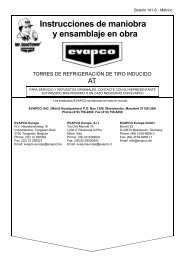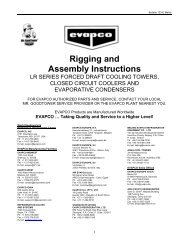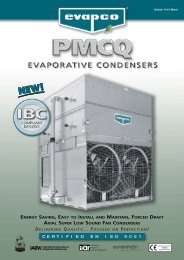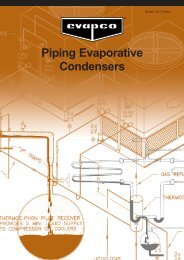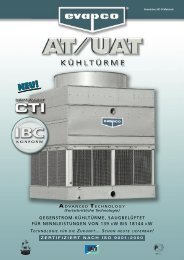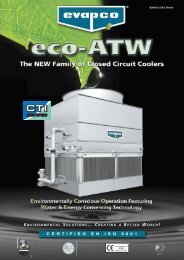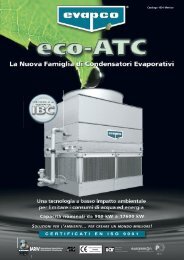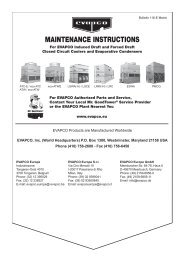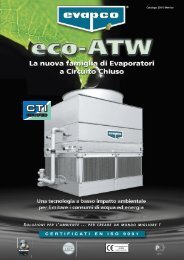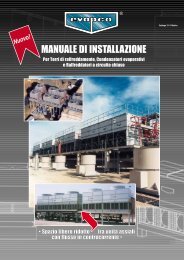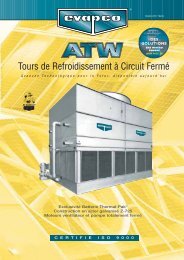You also want an ePaper? Increase the reach of your titles
YUMPU automatically turns print PDFs into web optimized ePapers that Google loves.
APPLICATIONS AND WATER QUALITY<br />
Design<br />
<strong>EVAPCO</strong> equipment is constructed of the highest quality<br />
materials and designed to provide years of reliable service<br />
when properly installed and maintained. The following<br />
sections present items which must be considered prior to<br />
the selection and installation of equipment.<br />
Structural Steel Support<br />
The recommended method of support for Evapco coolers is<br />
two structural “I” beams located under the outer flanges<br />
and running the entire length of the unit. Mounting holes<br />
19mm in diameter, are located in the bottom channels of<br />
the pan section to provide for bolting to the structural<br />
steel; refer to certified drawings from the factory for bolt<br />
hole locations.<br />
Beams should be level before setting the unit in place. Do<br />
not level the unit by shimming between it and the “I”<br />
beams as this will not provide proper longitudinal support.<br />
Consult Evapco or Evapco's iES program for steel support<br />
drawings.<br />
Equipment Layout Planning<br />
Proper equipment layout is essential to ensure that the<br />
fluid cooler operates at its rated capacity. Since<br />
evaporative cooling equipment requires large quantities<br />
of fresh air for cooling, it is important that the unit be<br />
located where the air supply is fresh and unobstructed.<br />
The unit should also be located so that recirculation of the<br />
moist discharge air is minimized. Recirculation, also<br />
known as short-cycling, occurs when some of the warm,<br />
moist air discharge flows back to the unit’s air inlet. The<br />
recirculation affect results in higher wet bulbs to the unit,<br />
which has a negative impact on the unit’s field<br />
performance.<br />
Engineering Bulletin No. 311 presents the Layout<br />
Guidelines for Evapco cooling towers, fluid coolers and<br />
evaporative condensers. This bulletin is available from<br />
your local representative, or it can be downloaded from<br />
www.evapco.eu<br />
The closed circuit cooler should be located away from<br />
fresh air intakes, operable windows, kitchen exhaust, and<br />
prevailing winds directed toward public areas.<br />
Closed Circuit Applications<br />
Closed Circuit Coolers are designed to be used on "Closed<br />
Loop" systems where the cooling loop is sealed and<br />
pressurized. These units are not intended for use in<br />
"Open Systems" where the cooling fluid has atmospheric<br />
contact.<br />
If applied in open systems, the coil may corrode from the<br />
inside with rust deposition throughout the cooling loop.<br />
The cooling fluid must be compatible with the coil<br />
material; standard coils are fabricated from black steel<br />
with the outer surface hot dip galvanized.<br />
Piping<br />
Supply and return piping for fluid coolers should be<br />
designed and installed in accordance with generally<br />
accepted engineering practice. The piping layout should<br />
be symmetrical for systems with multiple units, and should<br />
be sized for a low water velocity and pressure drop.<br />
Since these units are intended for "Closed Loop"<br />
applications, the loop piping should include an expansion<br />
tank to allow for fluid expansion and to purge excess air<br />
from the system.<br />
The piping system should include air vents and drain<br />
valves at the coil piping so that the coil can be drained if<br />
the need arises.<br />
All piping external to the unit should be secured and<br />
anchored by properly designed hangers and supports. No<br />
external loads should be placed upon the coil connections<br />
nor should any pipe supports be anchored to the unit.<br />
Recirculating Water Quality<br />
It is recommended that Evapco or another qualified water<br />
treatment company be contacted to design a water<br />
treatment protocol specifically for equipment and<br />
location.<br />
Closed circuit coolers reject heat by evaporating a portion<br />
of the water spray and discharging it as hot, saturated air.<br />
As the spray water evaporates, it leaves behind the<br />
mineral content and impurities of the supply water. If left<br />
untreated, these residuals become concentrated and lead<br />
to a buildup of scale, corrosion, and biological fouling.<br />
Bleed off<br />
To avoid this build-up of residuals, closed circuit coolers<br />
are provided with a bleed valve which allows for a portion<br />
of the spray water to be continually drained from the<br />
unit. The bleed valve, which is located on the pump<br />
discharge, should be set to the "fully open" position so as<br />
to ensure a sufficient bleed rate. Another method to<br />
remove residuals is to use a conductivity controlled<br />
blowdown device. This method should also be considered<br />
for water savings. If the bleed is reduced, the unit should<br />
be checked periodically to ensure the chemistry of the<br />
spray water is within the recommended guidelines as<br />
noted in Evapco’s Operation and Maintenance<br />
Instructions.<br />
Water Treatment<br />
In some cases the make-up water will have high impurity<br />
levels and a normal bleed will not be enough to prevent<br />
scale formation. In these cases, the services of an<br />
experienced water treatment company should be<br />
retained.<br />
Whatever chemical treatment program is prescribed for<br />
the given conditions, it must be compatible with the unit’s<br />
materials of construction, including the galvanized coil. If<br />
an acid is used to control pH, it should be accurately<br />
metered in dilute solution such that the spray water is<br />
held between a pH of 6,5 and 8,0. Batch feeding of<br />
chemicals is not recommended.<br />
Units constructed of galvanized steel operating with<br />
circulating water having a pH of 8,3 or higher may require<br />
periodic passivation to prevent the formation of white<br />
rust. White rust is a corrosion byproduct of the protective<br />
zinc barrier and appears on the metal surface as white,<br />
waxy formations. If white rust forms and is left<br />
untreated, it may flake off and leave the bare metal<br />
substrate exposed.<br />
Control of Biological Contaminants<br />
In addition to the above considerations, the water<br />
treatment program should include a biocide treatment to<br />
control contaminants such as algae, slime and legionella.<br />
At initial start-up or after an extended shut down, the<br />
unit should be drained and thoroughly cleaned. The unit<br />
should then be refilled with fresh water and provided an<br />
initial shock-treatment of biocide. A regular biocide<br />
monitoring and treatment schedule should be<br />
maintained thereafter.<br />
It is preferable that water treatment programs be<br />
implemented, monitored and maintained by an outfit<br />
experienced in the water treatment for cooling tower<br />
systems.<br />
ENGINEERING<br />
27



